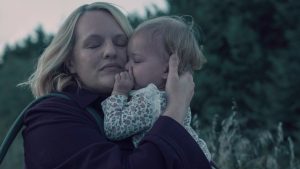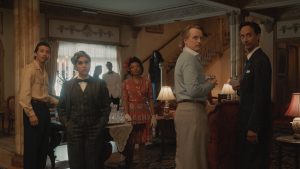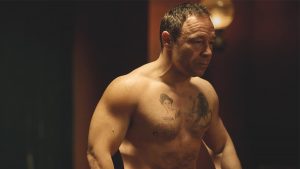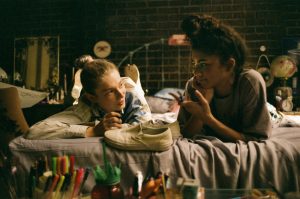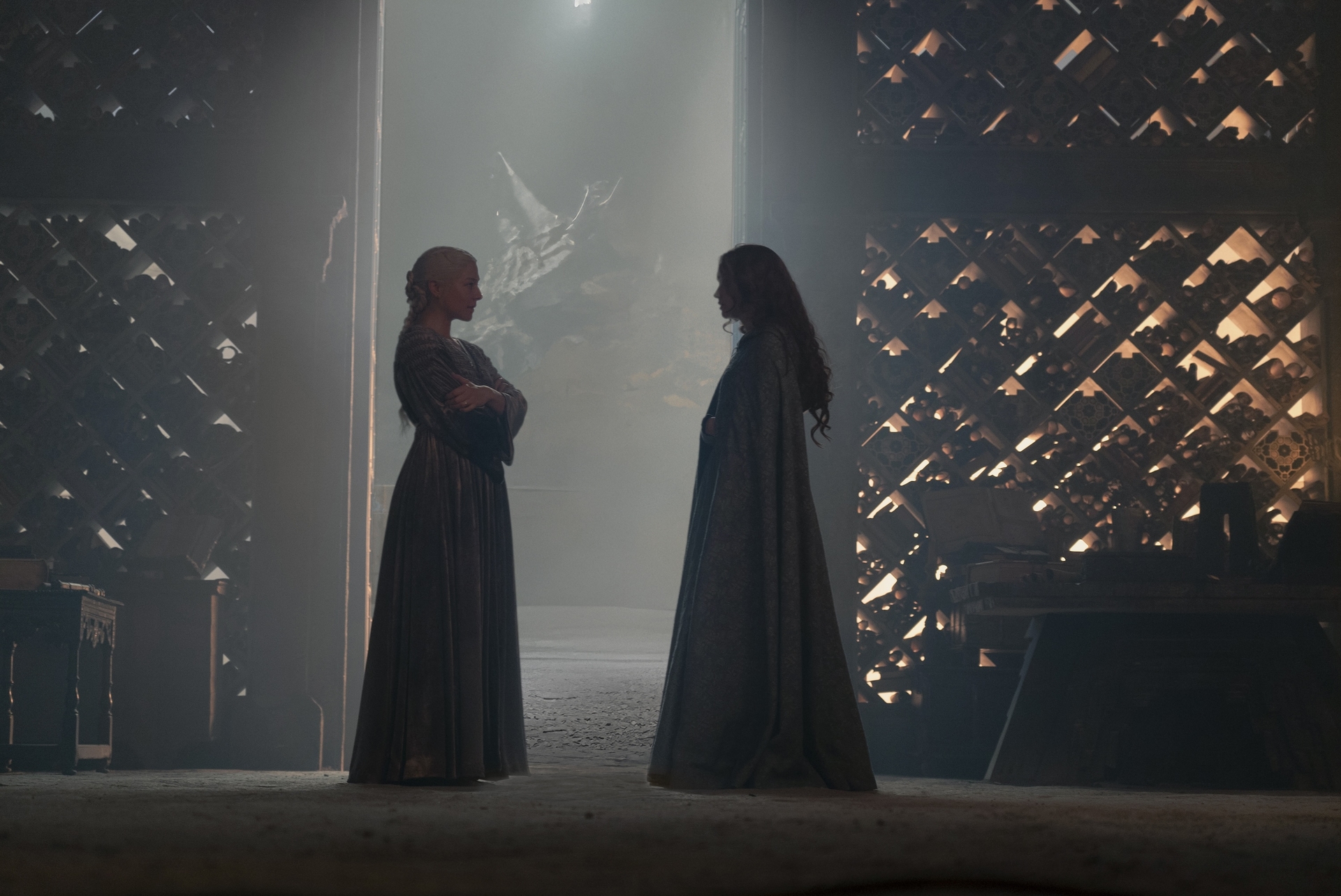
This article contains spoilers through the season 2 finale of House of the Dragon.
The relationship between Alicent Hightower (Emily Carey and Olivia Cooke) and Rhaenyra Targaryen (Milly Alcock and Emma D’Arcy) in House of the Dragon has yet to be defined as explicitly queer, but in this world, it’s no secret that queerness isn’t exactly celebrated. Laenor Velaryon (John Macmillan) literally had to fake his own death in order to be with the man he loved. But that doesn’t mean that queerness doesn’t still exist.
The first season of House of the Dragon sows the seeds within Alicent and Rhaenyra’s relationship subtly, so much so that the show was accused of queerbaiting for not making their feelings for each other more obvious and explicit. But a lot of the beauty of this relationship lies in the nuances. The small glances, the tender touches, the private moments shared. It all paints a tapestry across the first two seasons that shows the true depth of their love for each other.
Back when season 1 was airing, Emily Carey spoke with Variety about the accusations of queerbaiting the series had received and how she felt about her version of Alicent and her relationship with Rhaenrya. “Being a queer woman myself, it was something that I was conscious of. But I wasn’t consciously putting it out there,” Carey said. “They’re 14-year-old girls, they don’t know the difference between platonic and romantic. They don’t even know what the words mean, let alone what the feelings mean.”
Milly Alcock and Carey also both spoke with Business Insider about Rhaenyra and Alicent’s relationship in the context of the patriarchal, misogynistic world they live in. “Milly always says it’s like a tactile closeness and emotional closeness,” Carey says. “Especially when it’s put in the context of this world where they are the only two young girls in the Red Keep.”
“These women aren’t given the privilege to know what choices they have because of the world that they live in,” Alcock says. “That’s the theme that runs through this entire story, and Alicent and Rhaenyra’s relationship is a prime example of it.”
Adolescence is already a challenging time for youth, young women especially, as they try to figure out who they are and where they fit in the world. Add on to that a lack of language for and understanding of the feelings they are feeling, and it can compound, complicating relationships and how they feel like they fit into the world. How could Rhaenyra and Alicent possibly talk about or share their true feelings for one another when they don’t fully understand them?
But just because they don’t know how to label the feelings they have for one another doesn’t make them any less valid or present, season 2 has made that abundantly clear. Alicent and Rhaenyra had already begun to drift apart in season 1 after Alicent was betrothed to Rhaenyra’s father, King Viserys I (Paddy Considine).
Even though they were trapped by the same patriarchal expectations, Alicent was jealous of the few freedoms that Rhaenyra was afforded as Viserys’ heir, and felt trapped within her own station. The nail in the proverbial coffin was Alicent’s decision to support her son Aegon I (Tom Glynn-Carney) as Viserys’ heir over Rhaenyra and usurp her throne.
Despite all of the tragedies committed on each side in the name of this war, Alicent and Rhaenyra’s love for each other manages to persist through season 2. The two times that the pair get to talk in secret, it’s clear that they still care about each other even when they are so diametrically opposed. Alicent shows visible regret when she learns that she misunderstood Viserys’ final words. Rhaenyra musters a smile when Alicent shares her plans to run away and be happy. It truly seems like the war could cease immediately if the men would just step aside and let these two rule together.
It’s no coincidence either that both of these scenes have the same amount of care put into them. Both “The Burning Mill” and “The Queen Who Ever Was,” episode 3 and 8 respectively, were directed by Geeta Vasant Patel, who clearly realizes how important Rhaenrya and Alicent’s relationship is to the greater story and conflict at large.
According to Patel, their dynamic is “absolutely” the love story at the center of the show. When filming the final shots of the season finale, Patel told that she “wanted [the shots] to contrast so that you feel the relationship between these two protagonists and these sisters, these lovers in a way.” Except now, Rhaenyra is the one trapped by the confines of her station and role in society while Alicent has more freedom to choose her own path.
Some people have compared Alicent’s confession to Rhaenyra as a “coming out” scene in a way. Even though Alicent never outright says “I love you,” or confesses any kind of romantic feelings toward her friend, this is the first time in her life she is able to truly vocalize what she wants. When Rhaenrya tries to remind her how unkindly history will look upon a woman who takes what she wants, Alicent simply replies “Let them think what they must, I am at last myself.”
And this version of herself wants Rhaenyra by her side in her new life. She asks Rhaenyra to come with her, to forgo this war and live the life they dreamed of as young girls. Even though Rhaenyra declines, choosing the role her father laid out for her, there’s clearly still love there between them. Romantic, platonic, sisterly, whatever kind of love the two still hold for each other has been a driving force for both characters as the war has progressed.
There are so many layers to their love story, complicated by a society who would rather go to war with itself than let two women in love lead them. Even if their feelings for each other are no longer romantic, the kind of love and support they have for each other after everything is antithetical to the society they were raised in. This world was made to pit them against each other, to keep them separate and in their lanes as mothers and wives while the men fight for dominance, but instead, their love has kept them tethered to each other, thinking of one another even as they are distanced by the politics of war.
House of the Dragon is at its best when it shirks the confines of its source material and explores the queerness hidden between the lines. Queerness isn’t just about sexuality or who you find attractive. It’s about operating outside of the standard expectations of society – a path that was already laid out for Rhaenyra when she was chosen as Viserys’ heir.
Now that Alicent is embracing her own queerness by running away from it all, it’s even more clear just how much their intertwined lives have affected Westeros as a whole. Their love story is at the center of it all, and who knows where Westeros would be had the two simply been allowed to explore their deeper feelings for each other in their youth.
The post The Queer Love Story at the Center of House of the Dragon appeared first on Den of Geek.
